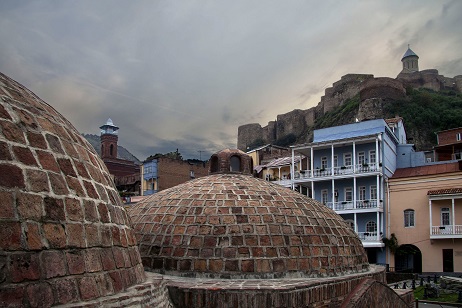Iconic Tbilisi bath house enjoys mosaic restoration

An ancient bath house in one of the most unique areas of Georgia’s capital Tbilisi is undergoing renovation works to cease ongoing damage and restore it to its original look.
Rehabilitation work has begun at the Orbeliani Bath House, which is considered to be one of the most unique and beautiful buildings in the Abanotubani (bath) district in old-town Tbilisi.
The Bath House boasts an ornate blue-tiled mosaic exterior, which now needs repair. It was owned by the famous Georgian noble Orbeliani family in the 18th Century.

Orbeliani Bath House with an ornate blue-tiled mosaic exterior. Photo by N.Alavidze/Agenda.ge
Currently, experts are trying to restore damaged parts of small blue domes which are located above each thermal bath.
Remedial work has been carried out in previous years by the National Agency for Cultural Heritage Preservation.
Meanwhile, the legend of the foundation of Tbilisi city is connected to the hot water springs where the Abanotubani district is now located.
In the 5th Century Georgia’s King Vakhtang Gorgasali was hunting in a forest in Tbilisi. The then capital city of Georgia was Mtskheta. During the hunt the King’s falcon caught a pheasant, after which both birds fell into a nearby hot spring and they were boiled.
This accident led to the discovery of the sulphuric hot springs and subsequently to the founding of Georgia’s new capital. The name Tbilisi is derived from the Georgian word Tbili, which means warm.
In old times when families did not have a private bath at home, they went to the sulphur baths to wash themselves. The hot springs were also believed to be good for a person’s health and could relieve ailments.
As public sanitation improved and baths became more common in private homes, the number of bath houses decreased to about 10. Nowadays,sulphur baths remain in place for relaxation and entertainment purposes.
Today, Tbilisi’s Abanotubani district remains one of the city’s most colourful and ethnically diverse places, where Georgian, Armenian and Catholic churches, a Mosque, Synagogue and even an Atashgah – an ancient Zoroastrian fire temple – are located near one another.
 Tweet
Tweet  Share
Share